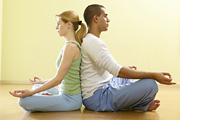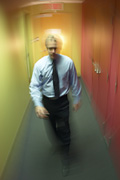Total behaviour
The behavioural system
One of Dr Glasser's major premises is that "All behaviour is purposeful". That is, ALL of our behaviour is our best attempt at the time, given the resources at our disposal (knowledge, skills, etc.) to meet our needs. Another way of putting it is all of our behaviour is an attempt at making the real world conform to the pictures in our quality world.
Most of the time we choose behaviours that Glasser terms organised behaviours. Used behaviours are ones that we are familiar with, that we have used before. For example, when I want to meet my need for fun, one of my organised behaviours is to go out to dinner with my partner and another couple. That is a behaviour that has worked firmly in the past.
If we do not have an organised behaviour immediately available, or organise behaviours that have worked in the past are not working in the current situation, we are capable of figuring out new behaviours. Glasser terms this process reorganising; this is our creativity, which is always going on, whether we decide to use it or not.
Total Behaviour
According to Dr Glasser all behaviour is total behaviour, made up of four components:
- Acting
- Thinking
- Feeling
- Physiology
All four components are present all the time, and we name our current behaviour by the most obvious component. Like the wheels of a car, if one wheel changes direction or speed, the others follow.
For example, if I am jogging, the most obvious component is the acting component. But while I am jogging, I may be thinking a number of things: "What a beautiful day!" or, "I love these new running shoes" or "I wonder if I can make it up this hill." I am also feeling something: exhilaration, possibly, or gladness, or maybe even a little fear at times. Simultaneously, my physiology is pumped up. My heart rates is up, my muscles are working, and I'm sweating. This would be in my total jogging behaviour. All four components are present, but we named the behaviour after the most salient component, acting.
In contrast, a behaviour named after the feeling component might be being angry. But while I am angry, I may be thinking, "How dare this person treat me this way!" I may be doing something like yelling or pacing. And my physiology would most likely include muscle tension and shallow breathing, among other things.
A behaviour named after the thinking component is meditating. While I am meditating, my acting behaviour would probably be sitting. My feeling component would be contentment, and my physiology would be slowed down.
Finally, a behaviour named after the physiological component is shivering. While I am shivering, I might be feeling frustrated. I might be thinking, "Why didn't I'd wear a coat?" and I might be doing anything I could think of to get warmer, running in place, cuddling up to my partner, etc.
All four of these components are occurring all the time, and when we change one of the components, the other three change accordingly.
What Can We Control?
According to Glasser, we choose all of our behaviours. The component we have the most control over is our acting. The next most easily controlled component is our thinking. Therefore, if we want to change the way we are feeling emotionally or physically, the most effective thing to do is to change what we are doing. If, because of the situation, we can't change what we are doing, we can change what we are thinking.
For example, if I have experienced frustration most of the day, I may be feeling angry, my body may be tense, I may be thinking "I hate my job!" and I may be complaining about it to a co-worker. The acting component of my behaviour, complaining, may not be helping me feel better physically or emotionally. So if I changed that component and, say, take a brisk walk, I will most likely change what I'm thinking, which will in turn help me feel better both emotionally and physically.
Activities
You can download of this activity sheet and use it with your group members
 For example, if I am jogging, the most obvious component is the acting component. But while I am jogging, I may be thinking a number of things: "What a beautiful day!" or, "I love these new running shoes" or "I wonder if I can make it up this hill." I am also feeling something: exhilaration, possibly, or gladness, or maybe even a little fear at times. Simultaneously, my physiology is pumped up. My heart rates is up, my muscles are working, and I'm sweating. This would be in my total jogging behaviour. All four components are present, but we named the behaviour after the most salient component, acting.
For example, if I am jogging, the most obvious component is the acting component. But while I am jogging, I may be thinking a number of things: "What a beautiful day!" or, "I love these new running shoes" or "I wonder if I can make it up this hill." I am also feeling something: exhilaration, possibly, or gladness, or maybe even a little fear at times. Simultaneously, my physiology is pumped up. My heart rates is up, my muscles are working, and I'm sweating. This would be in my total jogging behaviour. All four components are present, but we named the behaviour after the most salient component, acting. A behaviour named after the thinking component is meditating. While I am meditating, my acting behaviour would probably be sitting. My feeling component would be contentment, and my physiology would be slowed down.
A behaviour named after the thinking component is meditating. While I am meditating, my acting behaviour would probably be sitting. My feeling component would be contentment, and my physiology would be slowed down. For example, if I have experienced frustration most of the day, I may be feeling angry, my body may be tense, I may be thinking "I hate my job!" and I may be complaining about it to a co-worker. The acting component of my behaviour, complaining, may not be helping me feel better physically or emotionally. So if I changed that component and, say, take a brisk walk, I will most likely change what I'm thinking, which will in turn help me feel better both emotionally and physically.
For example, if I have experienced frustration most of the day, I may be feeling angry, my body may be tense, I may be thinking "I hate my job!" and I may be complaining about it to a co-worker. The acting component of my behaviour, complaining, may not be helping me feel better physically or emotionally. So if I changed that component and, say, take a brisk walk, I will most likely change what I'm thinking, which will in turn help me feel better both emotionally and physically.